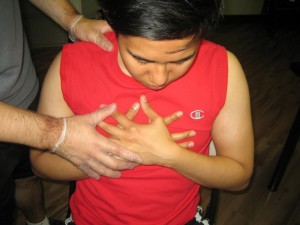Myocardial infarction (MI) is an area of the myocardium that is permanently destroyed. MI is normally a result of the reduction of blood flow to the coronary arteries due to rupture of an atherosclerotic plaque and ensuing occlusion of the artery by a thrombus. An unstable angina and acute myocardial infarction are considered to be of the same initial process but are considered to be at different points along the continuum. The term acute coronary syndrome (ACS) is usually used in lieu of the diagnosis wherein it is unclear whether the condition is that of an unstable angina or an acute myocardial infarction.
Pathophysiology of myocardial infarction
Causes of myocardial infarction include a wide variety of precipitating factors such as; vasospasm (sudden constriction or narrowing) of the coronary artery, decreased oxygen supply (such as from severe anemia, severe blood loss or low blood pressure) and the increase demand for oxygen (result of rapid heart rate or ingestion of cocaine. Regardless of each of the precipitating cause presented, there is a profound imbalance that exists between myocardial oxygen supply and the demand of the body. Coronary occlusion and heart attack are terms used interchangeably that both pertain to MI. The area of infarction develops over minutes to several hours which can occur suddenly or insidiously. As the cells are deprived of oxygen, ischemia develops along with cellular damage and the lack of oxygen results in infarction of the myocardial tissue or the death of the cells.
Clinical manifestations of myocardial infarction
Chest pain that occurs suddenly and continues despite rest and medication is the universal presenting manifestation of myocardial infarction. Some of the individuals who are afflicted with MI have prodromal symptoms or a previous diagnosis of a coronary artery disease. Patients with MI may present a combination of symptoms including chest pain, shortness of breath, indigestion, nausea, anxiety and a feeling of impending death.

Moreover, individuals who are experiencing the acute stage of the heart attack may have cool, pale and moist skin. Their heart rate and respiratory rate may be faster than baseline vital signs. These signs and symptoms which are caused by stimulation of the sympathetic nervous system may be present for only a short time or may persist even with rest and nitroglycerin. In many cases, the signs and symptoms of myocardial infarction cannot be distinguished from those of an unstable angina.
Medical management of myocardial infarction
The goal of medical management is to minimize myocardial damage, preserve
myocardial function and prevent complications thereafter. The aforementioned goals are facilitated by the use of guidelines adopted in the World Health Organization in their cardiac health policies. The goals may be achieved by reperfusion of the ischemic area with the use of emergency thrombolytic medications. Minimizing myocardial damage is best accomplished by reducing myocardial oxygen demand and increasing oxygen supply via oxygen supplementation administration, cardiac medications and complete bed rest without bathroom privileges. The resolution of pain as well as ECG changes will signal that reperfusion has occurred and that the heart is progressively towards recovery from myocardial infarction.